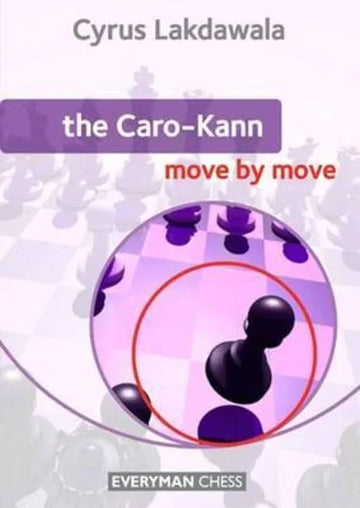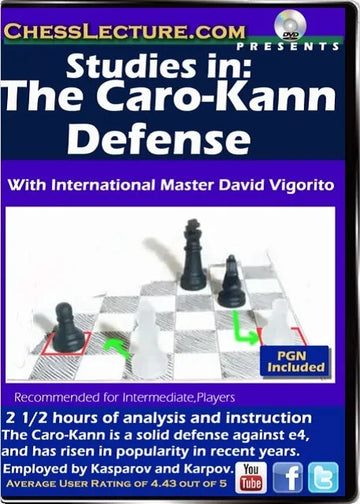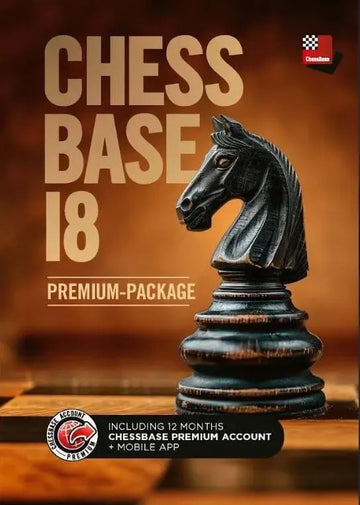Punish The Caro-Kann With The Advance Variation
If you choose to begin the game with 1. e4, then you will often be faced with the Caro-Kann Defense (1. …c6). The Caro-Kann has a solid reputation for Black, favored by players who seek a robust position out of the opening. White must play energetically to put the Caro-Kann to the test. The Advance Variation is an excellent way to do just that. It makes Black’s life difficult from the very outset.
In this article, we cover how to play the Advance Variation with White:
- Why to opt for the Advance Variation against the Caro-Kann Defense.
- Thematic ideas in the opening and early middlegame.
- Further recommendations to help add the Advance Variation to your opening repertoire.

Introduction To The Caro-Kann Advance Variation
The Caro-Kann Defense begins 1. e4 c6.

Related: Click here to learn how to play the Caro-Kann Defense with the Black pieces.
The idea behind 1. …c6 is to support the …d5 advance on the next move. The game normally continues 2. d4 d5.

White now has an important decision to make. Popular third-move options include:
- 3. exd5 - The Exchange Variation. White resolves the tension in the center immediately. This results in an imbalanced pawn structure once Black recaptures 3. …cxd5. White gets a queenside pawn majority, which may be favorable in an endgame.
- 3. Nc3 - The Classical Variation. White defends their e4 pawn while developing their queenside knight. Black usually captures via 3. …dxe4, and once White recaptures 4. Nxe4 we reach the start of one of the most well-studied lines in the Caro-Kann.
- 3. f3 - The Fantasy Variation. Supports the e4 pawn another way. If Black were now to capture 3. …dxe4, White can maintain their strong pair of central pawns via 4. fxe4. This variation appeals to aggressive chess players and can become very unbalanced. However, it is not considered completely sound, and is seldom seen at the elite level.
All of these moves have their pros and cons. However, our recommendation is 3. e5: The Advance Variation.

The Bothersome Pawn
The White pawn on e5 is quite bothersome for Black’s kingside development. Black’s kingside knight is denied the natural f6 square. Black’s knight may instead look to develop via the e7 square, but this in turn slows the development of Black’s dark-squared bishop.
As a result, Black often finds themselves cramped for space and behind in development in the Caro-Kann Advance Variation.
The opening statistics in games beginning with the Advance Variation favor White. At master level, White wins 43% of the time. This helps explain why the Advance Variation is the most popular way for White to fight against the Caro-Kann Defense.

Once White has played 3. e5, Black has two main ways of continuing:
- 3. …Bf5 - the “Main Line”, where Black gets their light-squared bishop into the game before playing …e6. The ability to develop their bishop outside of the pawn chain is one of the key advantages of the Caro-Kann for Black, as compared to the French Defense.
- 3. …c5 - the “Botvinnik-Carls Defense”, where Black immediately strikes at White’s center. The …c5 pawn break is important for Black in many lines of the Caro-Kann. However, it is worth noting that this advance has cost Black an extra tempo. Black has spent two moves moving their pawn from c7 -> c6 -> c5, instead of playing c7 -> c5 directly, as Black is often able to do in the French Defense.
Now let us take a look at some typical ideas that frequently occur in the Advance Variation.
Thematic Caro-Kann Middlegame Ideas For White
Punishing Black’s Slow Development
As we have already mentioned, Black can find themselves lagging behind in development in the Advance Variation. Black’s king is often slow to get castled.
In the below position, Black has made several inaccuracies.
- Black has traded off their only active piece (the light-squared bishop).
- Earlier, Black played …a6, a non-developing move.
- Now, Black has just advanced …c5. While this pawn break is a common move Black often plays, in this position it is premature, given Black’s severe lack of development.
It is White to move. How should White exploit their opponent’s lazy opening play?

White’s best move is to add more tension to the center via c4!

Astute observers will notice that White’s c4 pawn is actually undefended. However, if Black were to capture it via …dxc4, White has the powerful rejoinder d5!

Through this pawn sacrifice, White is forcing the center open. Meanwhile, Black’s king is still on e8. White will soon ramp up the pressure against the exposed Black king with decisive effect.
The Aggressive g4 Advance
The d4 pawn is often a weakness for White in the Caro-Kann Defense. One of Black’s main plans is to attack it. In the game Rublevsky vs. Asrian, 2008, the following position was reached, with White to move.

Black’s knight on f5 is well-placed, exerting pressure against White’s d4 pawn. Rublevsky, with the White pieces, deployed a standard idea by kicking the knight away via 11. g4.

To the untrained eye, pushing a pawn like this in front of White’s own king may seem risky. But in reality, White’s king is in very little danger due to the fact that the center is closed. The g4 advance gains even more space for White. The willingness to make aggressive pawn pushes such as this are often essential to White’s chances in the Caro-Kann Advance Variation.
The d6 Outpost
The d6 square is always worth keeping an eye on, especially when Black’s dark-squared bishop is traded off, or moves away from covering this square. In the below position, Black’s bishop seems to have White’s knight on c3 pinned in front of the rook on a1. How should White react?

White has the chance to make a strong exchange sacrifice with Nb5! Now, if Black were to capture the White rook via …Bxa1, White’s knight reaches the crucial d6 square with check: Nd6+.

Once the Black king moves, White will capture Black’s dark-squared bishop via Rxa1 next. Black’s weakened dark squares and inability to castle their king gives White full compensation for the exchange.
How To Get Started With The Caro-Kann Advance Variation
This article has covered everything you need to start playing the Advance Variation against the Caro-Kann Defense. So go ahead and dive right in!
We recommend first giving it a try in online blitz chess, or in casual (non-rated) games, so that you can gain some practical experience without risking your hard-earned rating in an opening variation which you are still new to.
If you want to play the Advance Variation in serious competition, you should take your study further. We have a recommended book and a recommended video course to take your knowledge of the Advance Variation to the next level.
Book Recommendation
Alexey Dreev’s Attacking the Caro-Kann is the go-to resource to learn the Advance Variation with White.

Related: Tips To Find The Right Chess Book For You.
The author is also well-known for playing the Caro-Kann Defense with the Black pieces. Now, Dreev brings his deep understanding of the Caro-Kann from the Black side to help put your opponents to the greatest test when playing with White.
Packed with expert analysis and instructive model games, this book is the perfect way to learn the Caro-Kann Advance Variation.
Video Course Recommendation
You prefer to learn via video, then you can’t go past Understanding Middlegame Strategies Vol. 10 - Caro-Kann Advance Variation from Ivan Sokolov.

This resource is suitable for all levels - from beginners to higher-rated players. You will learn how to keep the pressure up against the Caro-Kann and pose difficult questions to your opponent at every turn.
It features:
- 7 hours 19 minutes of lessons.
- Interactive training including video feedback.
- Assisted analysis.
Summary: Is The Caro-Kann Advance Variation Right For You?
The Advance Variation could become your main weapon against the Caro-Kann Defense if you:
- Like to challenge your opponent in the opening: Black’s awkward kingside development makes White’s early play easier. You should look to gain the initiative from the very start of the game.
- Enjoy attacking chess: White’s greatest chances in the Advance Variation often revolve around attacking the Black king. White must play actively. You should be the sort of chess player who prefers to preserve dynamic chances and to avoid trading queens.
- Learn the opening theory: The Caro-Kann Defense is a fundamentally solid opening, meaning that White must play accurately to cause problems for Black. Therefore, your odds of victory will be enhanced if you take the time to commit the most important lines to memory.
Is that the kind of chess opening for White that you would enjoy? If so, try the Advance Variation and punish the Caro-Kann today!









